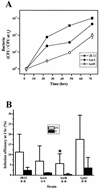Legionella pneumophila catalase-peroxidases are required for proper trafficking and growth in primary macrophages
- PMID: 12874332
- PMCID: PMC166045
- DOI: 10.1128/IAI.71.8.4526-4535.2003
Legionella pneumophila catalase-peroxidases are required for proper trafficking and growth in primary macrophages
Abstract
Legionella pneumophila, a parasite of aquatic amoebae and pathogen of pulmonary macrophages, replicates intracellularly, utilizing a type IV secretion system to subvert the trafficking of Legionella-containing phagosomes. Defense against host-derived reactive oxygen species has been proposed as critical for intracellular replication. Virulence traits of null mutants in katA and katB, encoding the two Legionella catalase-peroxidases, were analyzed to evaluate the hypothesis that L. pneumophila must decompose hydrogen peroxide to establish a replication niche in macrophages. Phagosomes containing katA or katB mutant Legionella colocalize with LAMP-1, a late endosomal-lysosomal marker, at twice the frequency of those of wild-type strain JR32 and show a decreased frequency of bacterial replication, in similarity to phenotypes of mutants with mutations in dotA and dotB, encoding components of the Type IV secretion system. Quantitative similarity of the katA/B phenotypes indicates that each contributes to virulence traits largely independently of intracellular compartmentalization (KatA in the periplasm and KatB in the cytosol). These data support a model in which KatA and KatB maintain a critically low level of H(2)O(2) compatible with proper phagosome trafficking mediated by the type IV secretion apparatus. During these studies, we observed that dotA and dotB mutations in wild-type strain Lp02 had no effect on intracellular multiplication in the amoeba Acanthamoeba castellanii, indicating that certain dotA/B functions in Lp02 are dispensable in that experimental model. We also observed that wild-type JR32, unlike Lp02, shows minimal contact-dependent cytotoxicity, suggesting that cytotoxicity of JR32 is not a prerequisite for formation of replication-competent Legionella phagosomes in macrophages.
Figures








References
-
- Amemura-Maekawa, J., S. Mishima-Abe, F. Kura, T. Takahashi, and H. Watanabe. 1999. Identification of a novel periplasmic catalase-peroxidase KatA of Legionella pneumophila. FEMS Microbiol. Lett. 176:339-344. - PubMed
-
- Bachman, M. A., and M. S. Swanson. 2001. RpoS co-operates with other factors to induce Legionella pneumophila virulence in the stationary phase. Mol. Microbiol. 40:1201-1214. - PubMed
Publication types
MeSH terms
Substances
Grants and funding
LinkOut - more resources
Full Text Sources
Molecular Biology Databases
Miscellaneous

